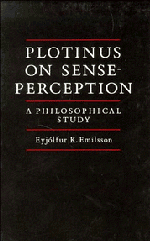Book contents
- Frontmatter
- Contents
- Acknowledgements
- Introduction
- I Plotinus' metaphysics
- II Plotinus' views on the soul and man
- III The relation between the eye and the object of vision
- IV Sensory affection
- V The unity of the senses
- VI The objects of perception
- VII Perceptions as acts and forms in perception
- VIII Conclusions
- Abbreviations
- Notes
- Bibliography
- Index
I - Plotinus' metaphysics
Published online by Cambridge University Press: 07 May 2010
- Frontmatter
- Contents
- Acknowledgements
- Introduction
- I Plotinus' metaphysics
- II Plotinus' views on the soul and man
- III The relation between the eye and the object of vision
- IV Sensory affection
- V The unity of the senses
- VI The objects of perception
- VII Perceptions as acts and forms in perception
- VIII Conclusions
- Abbreviations
- Notes
- Bibliography
- Index
Summary
The most striking feature of Plotinus’ philosophy, and of Neoplatonism generally, is its hierarchical picture of reality. This is also the feature that is most baffling for modern readers. In Plotinus’ philosophy we come across a hierarchy of three so-called “hypostases” that are called “the One”, “Intellect” and “Soul”, followed by matter at the bottom. Similar ideas characterize the writings of the other Neoplatonists. We are told that reality is somehow constituted by this hierarchy, an idea which we presumably find quite puzzling. If we look for arguments for it as such, we do not find any: it seems to be taken for granted. And if we encounter something that looks like an argument for some part of the hierarchy, we feel that it invariably presupposes the general picture.
As a first step towards approaching the Neoplatonic hierarchy, let us consider the ideas of a principle and of a hierarchy of principles. Let us suppose that there is a need to explain in general terms some phenomenon that is taken to be a fact of common experience. This may lead to the supposition of a level of entities or properties or forces, that are taken to be “behind” or “above” the ordinary phenomena, such that by supposing these entities, properties or forces to be there, an explanation has been given of the ordinary phenomenon that needed explanation. At this point we have already divided reality into two levels, the level of ordinary experience and a “more basic” level.
- Type
- Chapter
- Information
- Plotinus on Sense-PerceptionA Philosophical Study, pp. 10 - 22Publisher: Cambridge University PressPrint publication year: 1988



